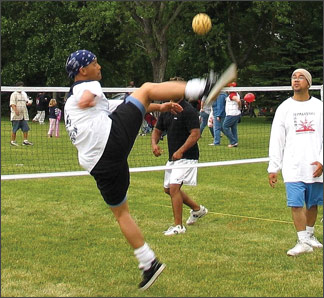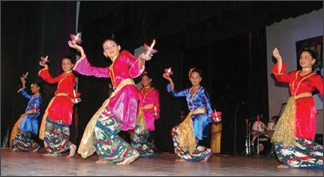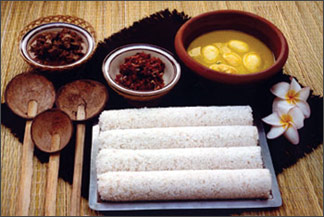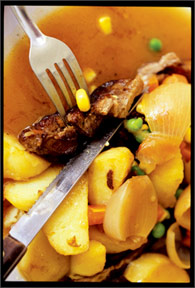Malay Padang

‘Sepak Takraw’ or ‘Ragey’

Malaysian martial arts ‘Silat’ now modified into a dance

‘Tari Lilin’ or the ‘Candle Dance’

‘Pittu’, a cuisine gifted by the Malays to their Sri Lankan
counterparts |

Malay Cuisine |
While some of us might be aware of Malay Rallies being held or ‘Malay
Padangs’ uniting Malays from all over the country, many of us are
ignorant as to what really goes on at these Malay events.
The Malay association has evolved a lot over time as a result of
interconnections with other Sri Lankan communities. However, with all
the distribution, Malays everywhere are united and they always gather
every year with the rest to form peaceful co-existence and strengthen
their ties.
Renowned and qualified Malay author of several Malay books, B. D. K.
Saldin gave his views “The Malay culture is unique because we have our
own culture, tradition, language, costumes, entertainment and delicious
food. In order to preserve everything that is Malay the need to get
together and have a Malay Rally at least once a year is vital”.
Malays from far-flung parts of the country come from 23 registered
Malay associations to gather at the annual Malay Rally. They are all
affiliated to the Sri Lanka Malay Association which provides the main
administrative umbrella.
The President of the Sri Lanka Malay Association (SLMA) Iqram
Cuttilan enlightened on Malay history “The Sri Lanka Malay Association,
Sri Lanka’s first Malay organisation was previously known as the All
Ceylon Malay Association.
The Colombo Malay Cricket Club where the Malay Association members
congregate is Sri Lanka’s oldest cricket club and one of the first clubs
to send cricket teams abroad”. The Colombo Malay Cricket Club was
inaugurated by Malay officers of the Ceylon Rifle Regiment in 1872 at
Slave Island.
The President of the Colombo Cricket Club Rohan Musafer stated that
“We try as much as we can to ask Malays to join the Colombo Malay
Cricket Club but it is disappointing to note that we don’t have a 100%
Malay team playing for the club so we are trying our best to change the
trend.” The aim of the Colombo Malay Cricket Club is to have an All
Malay team by the year 2010.
“The Malay Rally has evolved and changed much during the past ten
years the Malay Rally has changed which has been at the helm of
promoting Malay religion, culture, co-existence and this year’s Malay
Rally which will be held in August will revolve around the theme of
reviving the Malay language” stated the SLMA president.
“We have already started Malay classes and have requested the
Education Ministry to offer the Malay subject at the Ordinary and
Advanced Level examinations”, he added. It is a necessity to preserve
the Malay culture because intermarriages between the Malay community
with the rest has been commonplace.
We are all Sri lankans but we should be proud to be Malays, it is
such a shame that some Malays go to the extent of changing their names
to get recognition but being an ethnic minority, the Malay community
tries as much as they can to promote match making so that eligible young
Malays can find a suitable partner.
The dazzling beauty of the Malay costumes shine prettily at the Malay
Rally where the women wear the traditional Malay dress called ‘Baju
Kurung’.
This dress consists of a skirt with a slit in the front and a
long-sleeved blouse, where the styles can vary with a loose skirt like
the Malay style or a tight more shapely skirt worn by Indonesians. The
Malay men wear their attire of the maroon-coloured ‘sunku’ (Malay cap)
with a ‘sampin’ cover over their trousers with a long shirt. Some others
prefer to wear a batik shirt and trousers with the ‘sunku’.
The traditional Malay dances grace the stage during the night of the
Malay Rally with Malay culture including the ‘Tari Lilin’ or candle
dance, the ‘Retayang’ or umbrella dance and the more popular ‘Joget’
which is something like a mating dance where girls and boys participate
together.
The Malay martial arts sport called ‘Silat’ has now been modified to
a dance drill where boys line up and highlight the defensive moves.
Sports like ‘Sepak Takraw’ or ‘Ragey’ is a game where three players on
either side pass a ‘rattan’ ball on a field with a net (similiar to
volleyball).
The game doesn’t allow one to use one’s hands but using of players’
elbows, legs and head to keep the ball from falling to their playing
field. Points are tallied when the team hits the ball to the
opposition’s territory.
Positively, there are games that are played both in Sri Lanka,
Indonesia and Malaysia that are influenced by one another. “The game of
‘Leekeli’ in Sri Lanka, when it reaches its climax the captain shouts
‘habits’ (finished) and the word for finish in Indonesian is ‘habis’
while in Sri Lankan Malay is ‘abis’.
The Indonesian indoor game ‘congcak’ played with shells is similiar
to the Sinhala game of ‘pancha’” enlightens Saldin. All these games are
played at the Malay Rally with much enthusiasm for they not only keep
the games alive but also form unity within communities.
The Malay community has also gifted Sri Lankan cuisine with their
dishes like ‘pittu’, Malay pickle ‘acharu’, ‘babath and puruth’ (tripe)
and ‘nasi goreng’ (fried rice) which are firm favourites. Sri Lankan
Malay cook books by veteran chef Karthini Mohammed (nee Drahaman) have
been popular in not only uplifting Malay cooking but also have been
modernising and reinventing the Malay taste.
However, today the Malay ethnic minority has to pressurise the
government to voice their opinions because there is no Malay
representation in parliament.
“The numbers aren’t many so the Malay community have difficulty in
expressing their views”. The Malay community is keen to join other Sri
Lankan communities in order to promote peace and livelihood in Sri Lanka
together with the government.
- Nilma Dole |
